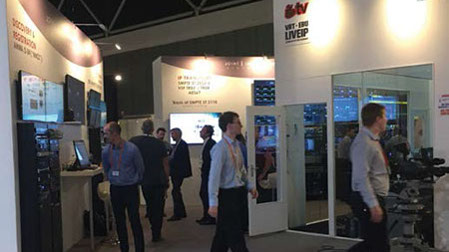IP in the Spotlight at NAB Show

LAS VEGAS—Throughout its informational sessions and on the show floor, a main focus of the 2017 NAB Show will be the broadcast industry’s transition to IP. One focal point will be the Broadcast Engineering and Information Technology Conference (formerly BEC), which has been designed for broadcast engineers and technicians, as well as media technology managers, contract engineers, broadcast equipment manufacturers, distributors, engineering consultants, and R&D engineers to address the pressing issues that face the industry.
This includes the ongoing transition to IT- and IP-based systems, with an emphasis on next-generation systems that are being adopted throughout the media-delivery ecosystem.

INTEROPERABILITY SHOWCASE
In addition to the conference sessions, the show will feature demonstrations of the convergence of IP for broadcast and examples of interoperability at the IP Showcase on the show floor. Sponsored by eight organizations including AES, AIMS, IABM, JT-NM members AMWA, EBU, SMPTE and VSF, as well as the Media Networking Alliance (MNA), the IP Showcase will play host to companies demonstrating dozens of new products.
“No doubt, the most exciting IP event at NAB 2017 will be the showcase,” said Thomas Edwards, vice president of engineering and development for Fox Networks Engineering and Operations. “Similar to the IBC IP Interoperability Zone, this booth in the North Hall of the LVCC is supported by the major players and will have about 40 companies showing IP interoperability. It goes a step beyond IBC, because it will concentrate on transport using the new SMPTE ST 2110 draft standard, as well as systemization with AMWA IS-04 registration and discovery and SMPTE ST 2059 PTP timing.”

The showcase, located in Booth N4824, “will show that NAB is really an association of bridge builders,” said Al Kovalick, founder of Media Systems consulting in Silicon Valley and cloud columnist for TV Technology.
“Right now we’re building bridges from SDI to IP, and this is going to continue for years as we’ll need those SDI to IP bridges.”
While IP may be the destination of the bridge to the future, SDI will still be a part of the broadcast world for the foreseeable future.
The professional video industry's #1 source for news, trends and product and tech information. Sign up below.
“12GB SDI will be around for a long time,” Kovalick added. “With point-to-point systems you can’t beat that, and it could be a long time until IP will be as convenient as SDI.”
STANDARDS AND PRACTICES
What likely won’t come out of this year’s NAB will be clear-cut standards, yet the industry is seeing true common cause with IP for broadcast. Several sessions kicking off the BEITC on Saturday, April 22 in Rm. N258 of the LVCC will provide updates on the industry’s transition.
“SMPTE ST 2110 Explained – What it is, What it Does, Why it Will Rule the World,” starting at 9:00 a.m., will address how even before being published, SMPTE ST 2110 has gained market support, as well as addressing what it does and why it’s important.
SMPTE will also highlight the recent advances in standards development at its booth (L28, Upper South Lobby), as well as offer details on upcoming educational conferences and programs, and showcase the diversity of its work to encourage and support student engagement in the motion-imaging field.
“The concerns for why people don’t want to go IP is that there is no standard,” said Stan Moote, CTO of IABM. “With a standard coming into view we’ll see more activity happening.”
However, even as the industry moves from SDI to IP, issues remain and the standards are just part of it. The “Status of IP Interoperability in the Broadcast Industry,” also at 9:00 a.m. on Saturday, will further address how the industry will make this transition.
“The standards are very far along,” said Kovalick. “This is going to be the horse to ride, but there are still issues to address.”

In the near-term those issues will likely be the costs involved, which is why some broadcasters will stick with SDI at least in some application models.
“The trend is and will always be to have the most cost-effective way to interconnect devices and right now 3GB SDI makes sense,” said Jim DeFilippis, CEO of TMS Consulting, Inc. in Los Angeles and columnist for tvtechnology.com. “IP has certain attributes but the story is never so straightforward. You can invest in IP, but in most use cases it is still a core routing technology not truly an interface technology. At end of day it is going to cost what it is going to cost.”
IP as it has been developed is ideal for sending data, which can be packetized and sent over routers and switches. The order in which the data arrives is generally trivial because it is data. However, the same isn’t as true in the case of video where every frame follows consecutively and there is a new frame to deal with, according to DeFilippis.
“This is why no one is doing true 4K over IP networking yet,” he said. “It requires compression to bring it down to more reasonable levels. In the same way SDI won’t go away anytime soon, even as it is used, could become limited to real-time production. Everything else is going to become file based, because it is compatible with data. Basically as long as it doesn’t have to adhere to a clock and get there reasonably quickly and error free, IP will be a good solution for sharing video.”
EDUCATING THE USERS
The NAB Show is a great place to learn about new technologies and while the IP transition is not exactly a “chicken and the egg” quandary, it does raise the question of whether broadcasters need to become IT professionals or the other way around. To this end, the International Association of Broadcast Manufacturers will be casting the spotlight on education at NAB.
The “Don’t Just Go IP, Go IT” session, also scheduled for 9:00 a.m. on Saturday in Rm. N258, will address the issues broadcasters are now facing, as well as the benefits of using IP for contribution and distribution. This session will further explore why broadcasters need to think IT, not just IP.
As you bring in IP workflows you have new ideas, new concepts and you need to be dealing with change management,” added Moote. “The simple fact is that IP guys don’t get broadcast, and the broadcast guys don’t know IP. There is too much to learn.”
During the transition, this should prompt broadcasters to train their people about IP, but Moote suggested there will still be a need to bring in a strong IP professional, “someone who knows the stuff from day one.
“But the IP guy needs to be indoctrinated into what broadcast is about,” he added. “It is really important that you put in the obvious, as the complexity should not scare anyone away.”
In many ways the industry’s young turks won’t need to completely displace the old guard, however, as this bridge to the future will still take time to fully cross.
“In the next 18 months there is going to need to be cross-fertilization between IT types and broadcast engineers,” said DeFilippis. “No one is going to push anyone out of a job either. Old timers are retiring or phasing out as many of these folks are aging Baby Boomers already.”
Thus, the personnel transition to IP could coordinate with the transition to the technology.
“This is going to follow what we’ve seen with other computer technology, where in 18 months IP will be twice as fast and half the cost,” said DeFilippis. “Everyone knows the price is coming down, so that creates opportunities. The key may be in recruiting new talent to fill the jobs.”
In the short-term just as IT and traditional engineers will likely co-exist and learn from one another, so too will IP be used alongside SDI.
“As this becomes more like working in a data center you’re not going to see that SDI connection, and IP will eventually dominate because it is what you live and die with in a data center,” said DeFilippis. “But SDI is still robust for now so no one should be panicking and ripping it out either.”
The bottom line may be that the transition will come as it is needed and fit usage models.
“IP is not change for change sake,” said Moote. “It is there for those who want to take advantage of the workflow benefits, and in the next few years those benefits will become ever more clear.”
